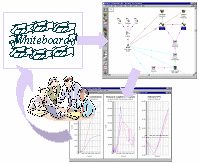The STEM business modelling software for networks offers a comprehensive range of
productivity-enhancing features built on an established process which focuses on
specific quantitative inputs and assumptions.
 An entry-level system
is now available from GBP1000 which models up to 30 elements of service demand and
equipment installation, and enables decision-making based on quantitative results
for a single consistent set of business assumptions.
An entry-level system
is now available from GBP1000 which models up to 30 elements of service demand and
equipment installation, and enables decision-making based on quantitative results
for a single consistent set of business assumptions.
This affordable licence package lowers the barrier to getting started with STEM
and uses the same process to create business logic so that you can focus on the
impact of strategic choices for a network business.
Creating business logic
How often have you started a ‘back of envelope’ analysis of a new business
opportunity, spent a fortnight getting the logic right and adding a range of essential
financial outputs, only to have a colleague (or even a client) spot a trivial error?
Business-case models are commonly built the hard way, from the bottom up each time
in a spreadsheet. As well as the laborious re-working of basic calculations that
this requires, editing at the cell level inevitably leads to subtle copy errors
which may only be detected by a time-consuming review process. Arbitrary modelling
techniques and a lack of high-level structure guarantee slow handover, as colleagues
must comprehend the business logic cell-by-cell.
STEM (Strategic Telecoms Evaluation Model) is a consistent language and flexible
framework for evaluating investments in telecoms business. This internationally
renowned business-modelling software is a time-based revenue, capex and opex calculator
which supports network roll-out and investment decisions, and a high-level communication
tool, which uses icons to represent the key drivers in a business plan.

Rapid model development process
STEM manages a complex structure of individually straightforward calculations to
help you focus on evaluating the financial impact of strategic choices for a network
business. The established STEM modelling process helps you unlock significant insights
through a critical focus on specific quantitative inputs and assumptions which apply
to any business model.
A few places are still available for our first open training session
in the week 6–10 February 2006 at Motorola’s Galvin Training Centre in Chicago.
Pricing for this 5-day, open (i.e. multi-client) course starts at GBP1250 per head,
depending on the final number of attendees. Another course is scheduled for the
week 8–12 May at our head office in Cambridge, UK. Please contact
Implied Logic for more details.
STEM enables flexible analysis of network economics
 STEM is designed
specifically for the agile development of business models that must be regularly
adapted to match the evolving shape of an operator’s revenues and costs. STEM models
can be rapid-prototyped, and are readily adaptable by virtue of the careful separation
of data from calculation structure, most of which is generated at run-time.
STEM is designed
specifically for the agile development of business models that must be regularly
adapted to match the evolving shape of an operator’s revenues and costs. STEM models
can be rapid-prototyped, and are readily adaptable by virtue of the careful separation
of data from calculation structure, most of which is generated at run-time.
A comprehensive modelling package is available when you are ready to invest the
necessary time to process and compare the results of a wide range of input parameters
and sensitivities, and to benefit from detailed financial reporting or node-level
technical analysis.
 STEM is a
flexible analytical system which provides user-definable inputs
and formulae, multi-dimensional scenario management and sensitivity analysis, and
which allows for the detailed risk analysis of a wide range of core and topic-specific
business model inputs.
STEM is a
flexible analytical system which provides user-definable inputs
and formulae, multi-dimensional scenario management and sensitivity analysis, and
which allows for the detailed risk analysis of a wide range of core and topic-specific
business model inputs.
STEM is a professional modelling package which offers template replication for repetitive
model structures, resource-level breakdown of costs allocated to services, and manages
the seamless integration of annual, quarterly and monthly inputs and outputs.
STEM is a logical tool which manages complexity in business modelling. The core
STEM proposition of managing a complex structure of calculations to help you focus
on evaluating the financial impact of strategic choices for a network business acquires
an increased significance with the comprehensive STEM system.
User-defined inputs and transformation outputs preserve the object-based approach
which is fundamental to the system-generation of calculation structure which increases
productivity and ensures clarity and reliability.
The integrated multi-dimensional scenario manager provides effortless agility in
the exploration of new scenarios, enabling new insights which are often too time-consuming
to explore in a spreadsheet, and guarantees a consistency of analysis throughout.
Native sensitivities are the fastest way to test the robustness of a model to uncertainty
in assumptions and future market conditions.
Template replication increases productivity through the automated copying and updating
of large, repetitive model structures, improving clarity and reliability and guaranteeing
consistency, especially when incremental structure is propagated through a model.
The resource-level breakdown of costs allocated to services delivers incomparable
detail and insight into the business realities within a network, as well as full
accountability (and debugging) of all resource costs.
The seamless and convenient integration of annual, quarterly and monthly inputs
and outputs bridges the gap between a ‘back of envelope’ calculation and a quarterly
business case which captures critical mid-year dynamics.
Management will have greater confidence in models built on the recognised structures
and professional features of a reliable, standardised business-modelling platform.